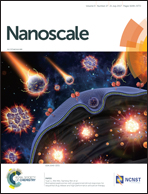Multifunctional electrospun polymeric nanofibrous mats for catalytic reduction, photocatalysis and sensing†
Abstract
Fabrication and decoration of flexible Nylon 6,6 polymeric nanofibrous mats for production of multifunctional electrospun material was accomplished via visible light-emitting surface-protected silicon quantum dots (Si QD), ZnO nanoparticles (ZnO NP) and Pd nanocubes (Pd NC). UV-range light was utilized for Si QD production and, after hydrolysis/condensation together with nucleation and growth reactions, amine-modified, fluorescent Si QD were obtained. Additionally, available molecular groups on the Si QD coated onto the polymeric nanofibrous mats provided further attachment of metal oxide and metal NP for various catalytic purposes. Analytical investigations showed that visible-light emission could be maintained on the Nylon 6,6 mats for trinitrotoluene (TNT) sensing. Also, due to consecutive NP decoration, multifunctional, polymeric, flexible nanofibrous mats were obtained. Experiments revealed that fabricated multifunctional mats could reduce molecules such as paranitrophenol effectively or decompose waste dyes such as methylene blue via photocatalytic experiments, and sense the pollutant TNT in aqueous solutions as an all-in-one concept.



 Please wait while we load your content...
Please wait while we load your content...